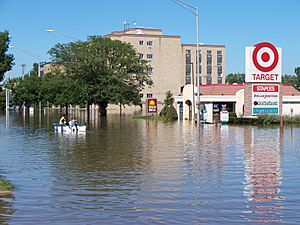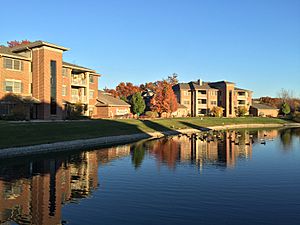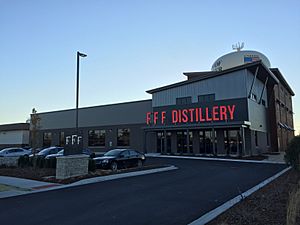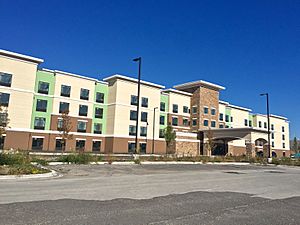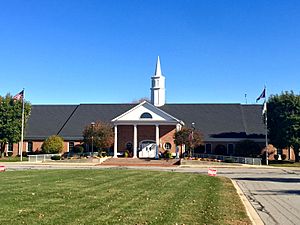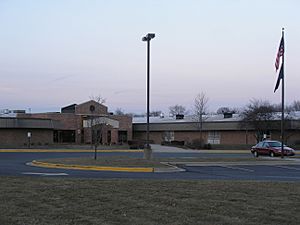Munster, Indiana facts for kids
Quick facts for kids
Town of Munster, Indiana
|
|
|---|---|
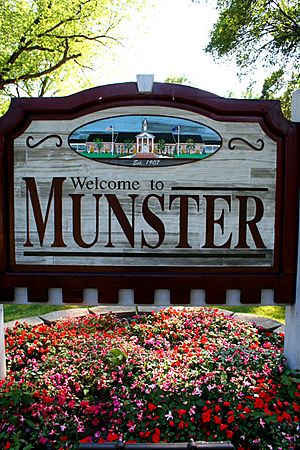 |
|
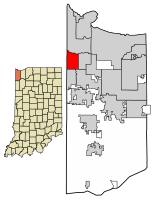
Location of Munster in Lake County, Indiana.
|
|
| Country | |
| State | |
| County | Lake |
| Township | North |
| Settled | 1850s |
| Incorporated | 1907 |
| Named for | Jacob Munster |
| Government | |
| • Type | Town |
| • Body | Town Council |
| Area | |
| • Total | 7.63 sq mi (19.75 km2) |
| • Land | 7.53 sq mi (19.51 km2) |
| • Water | 0.09 sq mi (0.24 km2) |
| Elevation | 614 ft (187 m) |
| Population
(2020)
|
|
| • Total | 23,894 |
| • Density | 3,172.33/sq mi (1,224.83/km2) |
| Demonym(s) | Munsterite |
| Standard of living (2008-12) | |
| • Per capita income | $34,735 |
| • Median home value | $197,600 |
| Time zone | UTC−6 (Central) |
| • Summer (DST) | UTC−5 (Central) |
| ZIP code |
46321
|
| Area code | 219 |
| FIPS code | 18-51912 |
| GNIS feature ID | 2396794 |
Munster is a town located in Lake County, Indiana, in the United States. It's a suburban area that is part of the larger Chicago metropolitan area. Munster is about 30 miles (48 km) southeast of downtown Chicago.
The town shares its borders with several other places. To the north is Hammond, to the east is Highland, and to the south are Dyer and Schererville. To the west, across the Illinois border, are Lansing and Lynwood. In 2020, about 23,894 people lived in Munster.
Contents
Munster's Location and Natural Features
Munster is built on an old shoreline of Lake Michigan. This area is known as the Calumet Shoreline. Today, this old shoreline is a road called Ridge Road. This road runs east and west through the northern part of town. Because of this, Munster is sometimes called the "Town on the Ridge."
The town has three small lakes. One of these lakes is in Centennial Park and is mostly marshy. The Little Calumet River borders Munster to the north. This river is shallow and has a thin wooded area around it. The Illinois state line forms the western border of the town.
In 2010, Munster covered about 7.65 square miles (19.81 km2) of land and water. Most of this area, about 7.57 square miles (19.61 km2), is land. The rest, about 0.08 square miles (0.21 km2), is water.
The Story of Munster: From Early Settlers to Today
Munster has a rich history. Two important historical buildings, the Ibach House and the Stallbohm Barn-Kaske House, are listed on the National Register of Historic Places.
Early Days of Munster
The first known people to live in this area were the Potawatomi tribe. Even though they didn't have a village exactly where Munster is now, they often used a dry, sandy trail. This trail is now known as Ridge Road. Today, many important town buildings, like the Town Hall and Post Office, are located on Ridge Road.
In the late 1600s and early 1700s, France claimed the land that is now Munster. Later, in the 1760s, the British took control of the area. But during the American Revolutionary War, George Rogers Clark fought the British and claimed the land for the new United States of America.
By the 1850s, more and more pioneer settlers moved to the Munster area. They started farms to grow crops and raise dairy animals. They sold their products in Chicago, which was a good market.
The town got its name from Jacob Munster. He was a young man from the Netherlands. In the 1860s, he opened a general store. Inside his store, he also had a U.S. postal station. Local farmers and settlers used this postal station often. Soon, it became an official United States Post Office and was named Munster after Jacob's store.
More people moved to the "Munster" area over time. In 1907, Munster officially became a town. A vote was held, and 76 residents voted "yes" to make it a town, while 28 voted "no."
Munster in Modern Times
Munster grew quickly and attracted many new residents. Like many places, Munster faced tough times during the Great Depression. During the Cold War, Munster was home to a special defense base called Nike-Zeus Missile defense base C-46. This base closed in 1971 and is now privately owned.
In September 2008, parts of northern Munster experienced flooding. This happened because of Hurricane Ike, which caused the Little Calumet River to overflow. A part of the levee (a wall built to prevent flooding) broke near Calumet Avenue. Munster asked the Army Corps of Engineers to make the levee higher in low areas. These improvements have been finished, and most of the homes that were damaged have been rebuilt.
Munster has plans for its future. The 2010 Comprehensive Plan includes ideas for a new town center. This center would have shops and restaurants and be built around a new train station.
People and Population in Munster
In 2011, the average income for a family in Munster was about $95,108. This was the highest average family income in Lake County. The average income per person in the town was about $36,914. Only a small number of families, about 2.3%, were estimated to be living below the poverty line.
Munster's Population in 2010
According to the census of 2010, Munster had 23,603 people living there. There were 9,015 households and 6,540 families. The town had about 3,118 people per square mile. There were 9,393 homes, with about 1,241 homes per square mile.
| Historical population | |||
|---|---|---|---|
| Census | Pop. | %± | |
| 1910 | 543 | — | |
| 1920 | 605 | 11.4% | |
| 1930 | 975 | 61.2% | |
| 1940 | 1,751 | 79.6% | |
| 1950 | 4,753 | 171.4% | |
| 1960 | 10,313 | 117.0% | |
| 1970 | 16,514 | 60.1% | |
| 1980 | 20,671 | 25.2% | |
| 1990 | 19,949 | −3.5% | |
| 2000 | 21,511 | 7.8% | |
| 2010 | 23,603 | 9.7% | |
| 2020 | 23,894 | 1.2% | |
| Source: US Census Bureau | |||
The people living in Munster in 2010 were mostly White (85.6%). There were also African American (3.5%), Asian (5.8%), and Native American (0.2%) residents. About 3.1% were from other backgrounds, and 1.8% were from two or more backgrounds. People who identified as Hispanic or Latino made up 10.2% of the population.
Out of the 9,015 households, 32.9% had children under 18 living with them. Most households (59.1%) were married couples living together. The average household had 2.59 people, and the average family had 3.10 people.
The average age of people in Munster was 44.8 years old. About 23.4% of residents were under 18. About 18.7% were 65 years old or older. The town had slightly more females (52.0%) than males (48.0%).
Businesses and Fun Places in Munster
Munster is home to many local and national businesses. It also has lots of community resources. Some of these include the Community Hospital and the Center for Visual and Performing Arts. You can also find The Times of Northwest Indiana newspaper here.
Other important places are a PepsiCo bottling plant and a Whole Foods Market distribution center. For fun, there's the Community Veterans Memorial, Centennial Park and Golf Course, and the Kaske House Museum at Heritage Park. Munster also has Bieker Woods Nature Area, miles of bike paths, and a Public Art and Sculpture Program.
Munster is also famous for the Three Floyds Brewing Company. This is a special brewery known for its "Dark Lord Day" event. This event brings 6,000 people to Munster every April.
Lake Business Center
In 2011, plans were updated for a big project called the Lake Business Center. This project cost $60 million and aimed to bring new businesses to Munster. It includes an Homewood Suites by Hilton hotel, which is a popular place for visitors to stay.
Centennial Village Development
One of Munster's newest projects is called "Centennial Village." This area is being redeveloped near Centennial Park. It will be a mixed-use area, meaning it will have both shops and homes. It's designed to be a place where people can live, shop, and easily access public transportation.
This project is part of a larger plan to improve roads and railroad crossings. The first part of the project, extending 45th Avenue and building an underpass under the Canadian National tracks, has been completed.
Getting Around Munster
The closest commercial airport to Munster is the Gary/Chicago International Airport in Gary. However, most people traveling to or from Munster use Chicago's O'Hare International Airport or the Chicago Midway International Airport. For smaller planes, Lansing Municipal Airport is nearby in Lansing, Illinois.
Munster is located just south of the Borman Expressway (I-80/94). Calumet Avenue is a main road that runs north-south through the town. This road becomes U.S. Route 41 just north of the Borman. Other major highways like Interstate 65, the Indiana Toll Road, and U.S. Routes 12, 20, and 30 are all within about 20-mile (32 km) of Munster.
Learning and Schools in Munster
The School Town of Munster is the public school system. All five schools in this system are highly recognized. They have been named Indiana Blue Ribbon schools and have received five-star ratings. Munster High School has been on Newsweek's Top Schools list many times. It was also recognized by The Washington Post's "The High School Challenge."
In 1875, Munster had only one school building with three rooms. It was on the corner of Calumet Avenue and Ridge Road. Before 1920, fewer than 50 students attended each year. In 1913, a second school building was added because more students were enrolling. The new Munster school opened in 1915. By the 1940s, it had grown to include twelve classrooms, a gym, and an auditorium. This school was renamed Lanier School in 1950.
As Munster's population grew, more schools were needed. James B. Eads Elementary School was built in 1948. Earnest R. Elliot Elementary School opened in 1952. With these new elementary schools, Lanier School became a Junior High School for grades 7-9. After 9th grade, students went to high schools in Hammond or Highland.
A new junior high school, Wilbur Wright Junior High, opened in 1960. This allowed Lanier to become an elementary school again. Later, a new, modern high school was planned. Construction for Munster High School began in 1965, and it opened its doors to students in September 1966.
In 1969, Frank H. Hammond Elementary School was added. It had 25 classrooms, an auditorium, and a learning center. The older Lanier school closed in 1980 because fewer students were attending.
Modern School Upgrades
Today, two of Munster's three elementary schools have been completely rebuilt. The new buildings for James B. Eads Elementary and Earnest R. Elliot Elementary were finished in 2003 and 2006. Wilbur Wright Middle School has also been expanded and renovated.
Munster High School has also seen many improvements. In 2010, a new football, track, and soccer complex was built. In 2011, a $17 million Aquatic Center was added. This center is one of only two school aquatic centers in Indiana. In 2012, a two-story classroom addition was built at the high school to fit more students.
The School Town of Munster started a program called 1 to 1 Technology in 2011-2012. This program gives laptop computers to all students in grades 5-12. It helps improve learning with technology, especially in science, technology, engineering, and math (STEM) subjects.
Private Schools in Munster
Munster also has two private schools. St. Thomas More Parish added a school in 1949. St. Paul's Lutheran school was founded in Hammond in 1886 and moved to Munster in 1981. Both schools serve elementary and middle school students.
- List of Public Schools - School Town of Munster
- Munster High School
- Wilbur Wright Middle School
- Ernest R. Elliott Elementary School
- James B. Eads Elementary School
- Frank H. Hammond Elementary School
- List of Private Schools
- St. Paul's Pre-school, Elementary, and Middle School (Lutheran Church–Missouri Synod)
- St. Thomas More Elementary and Middle School (Catholic, Diocese of Gary)
Fun and Recreation in Munster

Munster has many places for fun and recreation. There are ten parks, three lakes, a nine-hole golf course, and eleven miles of bike paths. The town also has a public art and sculpture program.
Centennial Park is the newest and largest park. It was built on an old landfill and opened in 2007. This park is special because it uses environmentally-friendly designs. For example, gas from the old landfill is captured and turned into electricity to power the park.
Centennial Park has a clubhouse with banquet rooms and a restaurant called The View. It also has a golf course, an amphitheater for live shows, and a lake with bridges and fountains. You can fish in the lake, walk on the boardwalk, and see sculptures. The park also has gardens, outdoor pavilions, walking trails, and a dog park. Events like the Munster Music Festival and fireworks are held here.
Community Park is another popular park in Munster. It hosts the town's annual Car and Motorcycle Show. This park has an outdoor swimming complex, a skate park, tennis courts, playgrounds, baseball fields, and a basketball court. It also has a social center and picnic areas.
Little League Baseball started in Munster in 1952, and Babe Ruth Baseball began in 1954. Munster's Babe Ruth All-Star teams have won six state championships since 1985.
- List of Parks and Recreational Facilities – Munster Parks & Recreation
- Beech Park
- Bieker Woods Nature Area
- Bluebird Park
- Briar Creek Park
- Burlwood Park
- Centennial Park
- Cobblestones Park
- Community Park
- Circle Park
- Evergreen Park
- Frank H. Hammond Park
- Grove Park
- Heritage Park & Kaske House Museum
- Military Memorial Park
- Munster Pool
- Rotary Park
- Sommerset Park
- Stewart Park
- Sunnyside Park
- Twin Creek Park
- White Oak Park
- The Veterans War Memorial
Famous People from Munster
Many notable people have connections to Munster:
- Stephan Bonnar, a mixed martial artist.
- Todd Donoho, a radio and television sportscaster.
- Nan Hayworth, a former U.S. Representative.
- Sue Hendrickson, a paleontologist who studies fossils.
- Jack Hyles, a minister and pastor.
- Tony Kanal, a musician from the band No Doubt.
- Mark Kruzan, a former mayor and state politician.
- Jeff Lee (swimmer), a former international freestyle swimmer.
- Joe Mansueto, who founded and is CEO of Morningstar, Inc..
- Don McCune, a former professional bowler and Hall of Famer.
- Ryan McMahen, a professional soccer player.
- Hal Morris, a Major League Baseball player.
- Mara Candelaria Reardon, a former member of the Indiana House of Representatives.
- Jerome Reppa, a lawyer and politician.
- Todd Rokita, who has served as Attorney General and Secretary of State of Indiana, and as a U.S. Representative.
See also
 In Spanish: Munster (Indiana) para niños
In Spanish: Munster (Indiana) para niños



